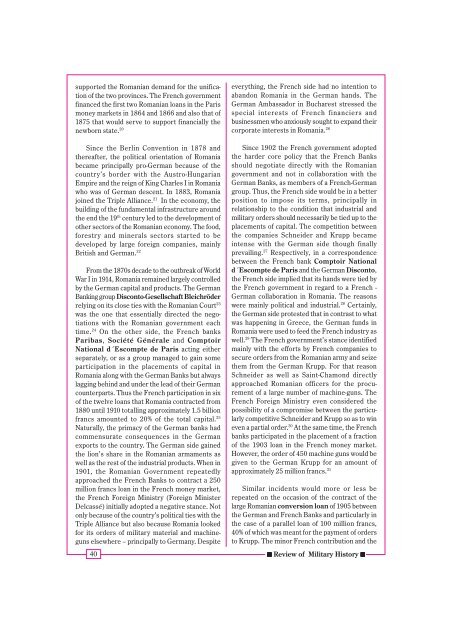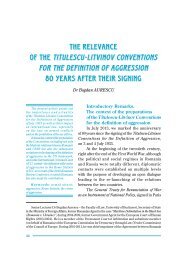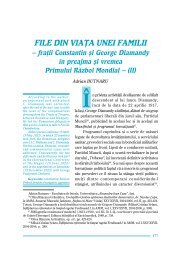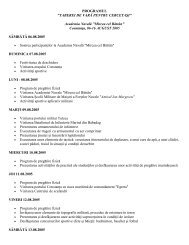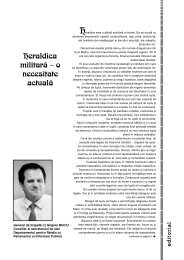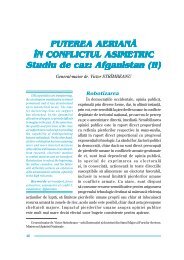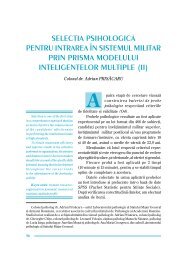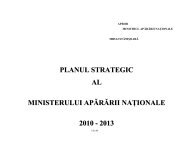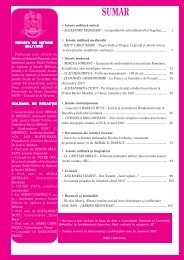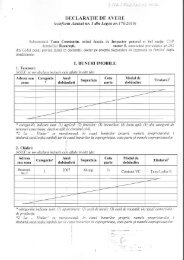Create successful ePaper yourself
Turn your PDF publications into a flip-book with our unique Google optimized e-Paper software.
supported the Romanian demand for the unification<br />
of the two provinces. The French government<br />
financed the first two Romanian loans in the Paris<br />
money markets in 1864 and 1866 and also that of<br />
1875 that would serve to support financially the<br />
newborn state. 20<br />
Since the Berlin Convention in 1878 and<br />
thereafter, the political orientation of Romania<br />
became principally pro-German because of the<br />
country’s border with the Austro-Hungarian<br />
Empire and the reign of King Charles I in Romania<br />
who was of German descent. In 1883, Romania<br />
joined the Triple Alliance. 21 In the economy, the<br />
building of the fundamental infrastructure around<br />
the end the 19 th century led to the development of<br />
other sectors of the Romanian economy. The food,<br />
forestry and minerals sectors started to be<br />
developed by large foreign companies, mainly<br />
British and German. 22<br />
From the 1870s decade to the outbreak of World<br />
War I in 1914, Romania remained largely controlled<br />
by the German capital and products. The German<br />
Banking group Disconto-Gesellschaft Bleichröder<br />
relying on its close ties with the Romanian Court 23<br />
was the one that essentially directed the negotiations<br />
with the Romanian government each<br />
time. 24 On the other side, the French banks<br />
Paribas, Société Générale and Comptoir<br />
National d´Escompte de Paris acting either<br />
separately, or as a group managed to gain some<br />
participation in the placements of capital in<br />
Romania along with the German Banks but always<br />
lagging behind and under the lead of their German<br />
counterparts. Thus the French participation in six<br />
of the twelve loans that Romania contracted from<br />
1880 until 1910 totalling approximately 1.5 billion<br />
francs amounted to 20% of the total capital. 25<br />
Naturally, the primacy of the German banks had<br />
commensurate consequences in the German<br />
exports to the country. The German side gained<br />
the lion’s share in the Romanian armaments as<br />
well as the rest of the industrial products. When in<br />
1901, the Romanian Government repeatedly<br />
approached the French Banks to contract a 250<br />
million francs loan in the French money market,<br />
the French Foreign Ministry (Foreign Minister<br />
Delcassé) initially adopted a negative stance. Not<br />
only because of the country’s political ties with the<br />
Triple Alliance but also because Romania looked<br />
for its orders of military material and machineguns<br />
elsewhere – principally to Germany. Despite<br />
everything, the French side had no intention to<br />
abandon Romania in the German hands. The<br />
German Ambassador in Bucharest stressed the<br />
special interests of French financiers and<br />
businessmen who anxiously sought to expand their<br />
corporate interests in Romania. 26<br />
Since 1902 the French government adopted<br />
the harder core policy that the French Banks<br />
should negotiate directly with the Romanian<br />
government and not in collaboration with the<br />
German Banks, as members of a French-German<br />
group. Thus, the French side would be in a better<br />
position to impose its terms, principally in<br />
relationship to the condition that industrial and<br />
military orders should necessarily be tied up to the<br />
placements of capital. The competition between<br />
the companies Schneider and Krupp became<br />
intense with the German side though finally<br />
prevailing. 27 Respectively, in a correspondence<br />
between the French bank Comptoir National<br />
d´Escompte de Paris and the German Disconto,<br />
the French side implied that its hands were tied by<br />
the French government in regard to a French -<br />
German collaboration in Romania. The reasons<br />
were mainly political and industrial. 28 Certainly,<br />
the German side protested that in contrast to what<br />
was happening in Greece, the German funds in<br />
Romania were used to feed the French industry as<br />
well. 29 The French government’s stance identified<br />
mainly with the efforts by French companies to<br />
secure orders from the Romanian army and seize<br />
them from the German Krupp. For that reason<br />
Schneider as well as Saint-Chamond directly<br />
approached Romanian officers for the procurement<br />
of a large number of machine-guns. The<br />
French Foreign Ministry even considered the<br />
possibility of a compromise between the particularly<br />
competitive Schneider and Krupp so as to win<br />
even a partial order. 30 At the same time, the French<br />
banks participated in the placement of a fraction<br />
of the 1903 loan in the French money market.<br />
However, the order of 450 machine guns would be<br />
given to the German Krupp for an amount of<br />
approximately 25 million francs. 31<br />
Similar incidents would more or less be<br />
repeated on the occasion of the contract of the<br />
large Romanian conversion loan of 1905 between<br />
the German and French Banks and particularly in<br />
the case of a parallel loan of 100 million francs,<br />
40% of which was meant for the payment of orders<br />
to Krupp. The minor French contribution and the<br />
40 ����� Review of Military History �����


